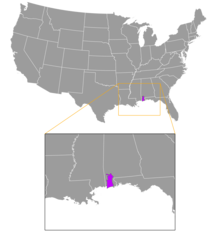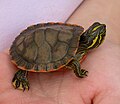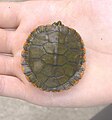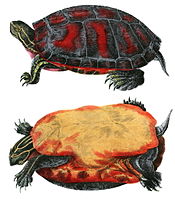| Alabama red-bellied cooter | |
|---|---|

| |
| Scientific classification | |
| Domain: | Eukaryota |
| Kingdom: | Animalia |
| Phylum: | Chordata |
| Class: | Reptilia |
| Order: | Testudines |
| Suborder: | Cryptodira |
| Superfamily: | Testudinoidea |
| Family: | Emydidae |
| Genus: | Pseudemys |
| Species: | P. alabamensis
|
| Binomial name | |
| Pseudemys alabamensis | |

| |
| Alabama red-bellied cooter range[3] | |
| Synonyms[4] | |
| |
The Alabama red-bellied cooter (Pseudemys alabamensis) or Alabama red-bellied turtle, is native to Alabama.[1][2] It belongs to the turtle family Emydidae, the pond turtles. It is the official reptile of the state of Alabama.[5]
Life history
[edit]The red-belly inhabits the fresh to brackish waters of the Mobile-Tensaw River Delta in Mobile and Baldwin counties.[2] It feeds on aquatic vegetation[6] and can be found sunning itself on logs. Nesting of the red-bellied turtle occurs from May through July. Female turtles lay their eggs on dry land, digging nests in sandy soil, where 4 to 9 eggs are laid. Hatchlings usually emerge during the summer. When the turtles nest in late July, hatchlings may overwinter in the nest and emerge the following spring.[citation needed]
A mature female can be 14 inches (360 mm), while a mature male can be 12 inches (300 mm).[6]
Location
[edit]As of June 2009 the turtle has been seen in the central part of Alabama, in the Elmore County region.[citation needed]
This turtle has also been found in south-eastern Mississippi,[7] in Harrison and Jackson counties.[6]
Protection
[edit]In 2007, a 3.4 miles (5.5 km) chain-link fence has been constructed along part of the US 98 causeway (Battleship Parkway) that separates the Mobile-Tensaw delta from Mobile Bay.[8] Hatchling deaths dropped 80% from 2007 to 2008.[citation needed]
Gallery
[edit]-
Hatchling
-
Hatchling, plastron
-
Hatchling, carapace view
References
[edit]- ^ a b c Rhodin, Anders G.J.; van Dijk, Peter Paul; Iverson, John B.; Shaffer, H. Bradley; Roger, Bour (31 December 2011). "Turtles of the world, 2011 update: Annotated checklist of taxonomy, synonymy, distribution and conservation status" (PDF). Chelonian Research Monographs. 5: 000.181. Archived from the original (PDF) on 31 January 2012.
- ^ a b c Tortoise & Freshwater Turtle Specialist Group (1996). "Pseudemys alabamensis". The IUCN Red List of Threatened Species. 1996. IUCN: e.T18458A97296493. doi:10.2305/IUCN.UK.1996.RLTS.T18458A8295960.en. Listed as Endangered (EN B1+2c v2.3)
- ^ U.S. Geological Survey (2017). "Alabama Red-bellied Cooter (Pseudemys alabamensis) rARBCx_CONUS_2001v1 Range Map". Gap Analysis Project. doi:10.5066/F7Z31XTN.
- ^ Fritz Uwe; Peter Havaš (2007). "Checklist of Chelonians of the World". Vertebrate Zoology. 57 (2): 192. doi:10.3897/vz.57.e30895. S2CID 87809001.
- ^ "Official Alabama Reptile". Alabama Emblems, Symbols and Honors. Alabama Department of Archives & History. 12 July 2001. Archived from the original on 25 January 2008. Retrieved 19 March 2007.
- ^ a b c "Alabama – Great Days Outdoors Magazine Fishing, Hunting – Dedicated to Sportsmen and Their Families". Archived from the original on 16 April 2014. Retrieved 7 October 2018.
- ^ Southern Wonder: Alabama's Surprising Biodiversity by R. Scot Duncan, University of Alabama Press, 2013, page 367, ISBN 9780817357504
- ^ "Turtle protectors on the Causeway – BaldwinReport.com". baldwinreport.com. Archived from the original on 16 April 2014.
External links
[edit]- Save the Alabama Red-bellied turtle—Alabama red-bellied turtle alliance





Well, that’s interesting to know that Psilotum nudum are known as whisk ferns. Psilotum nudum is the commoner species of the two. While the P. flaccidum is a rare species and is found in the tropical islands. Both the species are usually epiphytic in habit and grow upon tree ferns. These species may also be terrestrial and grow in humus or in the crevices of the rocks.
View the detailed Guide of Psilotum nudum: Detailed Study Of Psilotum Nudum (Whisk Fern), Classification, Anatomy, Reproduction